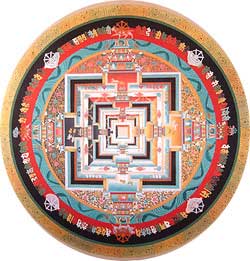Major Exhibition On Tibetan Buddhist Mandalas For The First Time In The Southeast At The Carlos Museum
Mi2N.com, Dec 12, 2011
Atlanta, GA (USA) -- The Michael C. Carlos Museum of Emory University will showcase the sacred art of Tibet in the special exhibition Mandala: Sacred Circle in Tibetan Buddhist from January 21 through April 15, 2012.
 For the first time in the Southeast more than 100 masterworks will bring to light the intricate, transcendental, and evocative manifestations and functions of the "perfect circle" or mandala used as an aid in meditation and as a tool to obtain enlightenment. The exhibition and accompanying educational programs will celebrate the rich religious and artistic tradition of Tibetan Buddhist and the spiritual significance of the mandala.
For the first time in the Southeast more than 100 masterworks will bring to light the intricate, transcendental, and evocative manifestations and functions of the "perfect circle" or mandala used as an aid in meditation and as a tool to obtain enlightenment. The exhibition and accompanying educational programs will celebrate the rich religious and artistic tradition of Tibetan Buddhist and the spiritual significance of the mandala.
Mandala is a Sanskrit word meaning "circle." Depicting a realm that is both complex and sacred, the mandala is a visualization tool meant to advance practitioners toward a state of enlightenment. The exhibition explores the various manifestations of these objects, simultaneously explaining their symbolism, describing how they fulfill their intended function, and demonstrating their correlation to our physical reality.
Visitors will find mandalas conceived as concentric circles, circles within squares, squares within circles, lotus blossoms, six-pronged stars, or inverted, crossed triangles. A deity, sometimes with a partner, is usually situated in the middle of the central disk, surrounded by four, six, eight, ten, twelve, or more assembly deities set in an additional circle.
As such, the mandala's very construct graphically mirrors the Buddhist notion of the cosmos and of the human being. In addition to paintings, reliquaries, and amulets, the exhibition includes tapestries, sculptures, and utensils used in sacred ceremonies and a time-lapse film of a mandala formed in sand.
While many of the works in the exhibition are from the collection of the Rubin Museum of Art in New York, the exhibition also includes masterpieces from other museums and private collections from around the world, including the Kimbell Art Museum, the American Museum of Natural History, the Philadelphia Museum of Art, the Ethnographic Museum of the University of Zurich, and Namgyal Monastery in Dharamsala, India. Mandala: Sacred Circle in Tibetan Buddhist was organized by the Rubin Museum of Art, New York. Support for the exhibition in Atlanta has been provided by the Shelley and Donald Rubin Foundation, the Emory-Tibet Partnership, and Drepung Loseling Monastery, Inc.
Education and outreach
Public educational programs in conjunction with the exhibition will offer many opportunities for visitors to learn about the complex imagery of these mandalas and their role in the practice of Tibetan Buddhist. Programs will draw on the intellectual depth of Emory University's faculty as well as distinguished scholars from other universities, visiting artists, and members of the Tibetan community in Atlanta. Tours for K-12 students and programs for teachers will serve the World Religions curriculum.
Examples of programs include:
- Christian Luczanits, curator at the Rubin Museum of Art, will present Dimensions of Sacred Space: Mandalas in Early Tibetan Buddhist Art and Architecture.
- NY Times columnist Rob Walker, author of Buying In: The Secret Dialogue of What We buy and Who We Are, and Bobbi Patterson, Emory professor, will discuss one of the Four Noble Truths of Buddhist—that suffering is caused by desire—and the complexity of navigating a culture in which "desire" is manufactured by product designers and advertising agencies, and driven by our own consumerism. This program is sponsored by the Emory Office of Sustainability Initiative.
- Sara McClintock, Emory professor, will speak about the five wisdom Buddhas who embody the enlightened wisdom to transform individuals through the transmutation of afflicted minds and bodies into enlightened ones.
- A four-week course led by Geshe Lobsang Tenzin Negi will introduce individuals to Tibetan Buddhist compassion meditation.
- Monks from Drepung Loseling Monastery will create a sand mandala of Guhyasamaja, which will remain intact in the galleries until the end of the exhibition when it will be ceremonially dismantled.
- Artist Kimberly Carmody from Urban River Arts in New York will lead participants in the creation of a giant Urban Mandala from recycled and repurposed materials. This program is sponsored by the Emory Office of Sustainability Initiative.
- Children will have the opportunity to observe the monks from Drepung Loseling Monastery, Inc. as they create the sand mandala and then make sand paintings of their own using traditional Tibetan copper tools and brightly colored sand.
- In addition to the exhibition at the Carlos Museum, Emory's Visual Arts Gallery will mount Contemporary Mandala: New Audiences, New Forms, an exhibition of the work of contemporary artists who use the mandala form as artistic expression and as a tool for transformation.
- A "living mandala" will be constructed across from the Museum, in the garden of Cannon Chapel. Designed by Emory landscape architect, James R. Johnson, and Buddhist monks from Drepung Loseling Monastery, Inc., the mandala, made from perennials, will become part of the permanent landscape.
Website: http://057960ab.tinylinks.co
Read More @ Source
Comments
Post a Comment